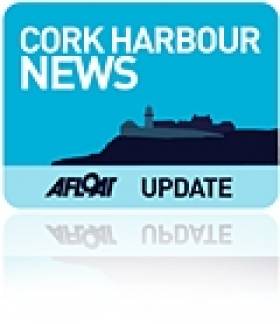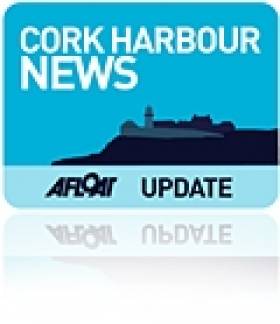Displaying items by tag: NMCI
NMCI Open Day: Let’s Sea What You’re Made Of
The open day is primarily aimed at fourth-year transition and leaving certicifcate students. For further information, enquiries and bookings for groups contact NMCI Tel: (021) 497 0607 by email: [email protected] and also the website: www.nmci.ie
Road, Rail or ‘Sail’ to Cobh
There's also the option of departing Cork-city centre to Cobh by taking an excursion on the River Lee on the passenger-tender Spirit of the Isles. Sailings depart the city's Penrose Quay, which is on the same side to the railway (Kent) station.
Sailings will operate this Saturday and Sunday and for the remaining weekends throughout September. The boat's Saturday schedule departs the city at 11am and arrives at Cobh's Kennedy Quay at 12.15pm.
In addition there is a Lower harbour tour off Cobh on Saturdays and Sundays, departing Kennedy Pier, Cobh - 12.30pm and returning to Kennedy Pier at 1.45pm. The boat then departs Cobh at 2pm to return to Cork with an arrival time of 3.15pm. For both this Saturday and Sunday sailing schedules, fares and further information go to www.corkharbourcruises.com
In the late 1980's the Spirit of the Isles then named Ingot operated excursions for several seasons from Dun Laoghaire's East Pier to Dalkey Sound and Killiney Bay.
Returning to the third annual Cork Harbour Open Day there will also be a free shuttle-service running in the lower harbour calling at Ringaskiddy, Monkstown, Cobh, Aghada and Crosshaven. The fast-ferry RIB operator 'Whale of a Time' is providing the free service which is sponsored by the Port of Cork Company and National Maritime College of Ireland (NMCI). For further information visit http://www.whaleofatime.net/Home.html
- Dun Laoghaire
- Cork Harbour
- port of Cork
- Cruise Liners
- River Lee
- Cork Harbour Open Day
- NMCI
- Cobh Cruise Terminal
- National Maritime College of Ireland (NMCI)
- Ports and Shipping News
- Cork Harbour News
- Irish Rail
- Port of Cork Company
- Cunard Line
- Queen Elizabeth
- Whale of a Time
- Cruise Liner news
- Dalkey Sound
- Cruise ship news
- Midelton Food & Drink Festival
- Ingot
- Killiney Bay
- Irish passenger excursion vessels
- Cork Harbour Cruises
- CorkCobh
- Cork (Kent) station
- Spirit of the Isles
Take a View From the Bridge
In the evening the Cork Corona Film Festival will hold a fundraiser themed the 'Amazing Cork Maritime Experience' at the NMCI from 5pm onwards.
Also in Ringaskiddy, at the Deepwater Quay, Fastnet Lines' 22,000 tonnes Julia will be open to the public between 11am to 3pm. This will allow those to tour the facilities of the 1,500 passenger/325 vehicle capacity ferry which has operated the year round Cork-Swansea route since last year.
To enable visitors to visit the events spread across the world's second largest natural harbour, a free shuttle-ferry service connecting Ringaskiddy, Monkstown,Cobh, Aghada and Crosshaven will be operating on the day. The ferry service is sponsored by the Port of Cork Company and National Maritime College of Ireland (NMCI).
- port of Cork
- Cork Harbour Open Day
- NMCI
- Fastnet Line
- National Maritime College of Ireland (NMCI)
- Ports and Shipping News
- Cork Harbour News
- Port of Cork Company
- Ferry news
- Portsand Shipping News
- Irish nautical college
- MVJulia
- Ringaskiddy Ferry Terminal
- CorkSwansea ferry route
- Cork Corona Film Festival
Countdown to Cork Harbour Open Day
This will be the third Cork Harbour Day which is to cover a wide range of events, such as concerts on Spike Island, a photographic exhibition in Camden Fort, guided tours of an Irish naval ship at Cork City Quays and an open day at the National Maritime College of Ireland (NMCI).
In addition Fastnet Line's ferry Julia will be open for the public to board. The 22,161 gross tonnes serves the Cork-Swansea route and for the Open Day she will be berthed at Ringaskiddy Deepwater Berth instead of the nearby ferry terminal. To read details of Open day programme visit www.corkharbour.ie and updates click HERE.
The concept for the Harbour Open Day emerged three years ago, which combined various stakeholders involved in the development and implementation of the Integrated Strategy for Cork Harbour. A group comprising of representatives from UCC, City and County Councils, the Naval Service and the Port of Cork set about working together to engage with users of the harbour and to organise the Open Day.
Cork Harbour is the second largest natural harbour in the world, next to Sydney Harbour, offering beautiful locations for enjoying the outdoors, dramatic coastlines, and excellent leisure facilities, and is home to some very talented artists, sportsmen and women, and people who are passionate about the history, heritage and cultural value of Cork Harbour.
- Spike Island
- Cobh
- Cork Harbour
- naval service
- National Maritime College of Ireland
- port of Cork
- Cruise Liners
- Cork Harbour Open Day
- NMCI
- Ports and Shipping
- Cobh Cruise Terminal
- Cork Harbour News
- Cunard Line
- Queen Elizabeth
- Cruise ships
- Cork City Quays
- Camden Fort
- Port of Cork Company
- Ringaskiddy Deepwater Terminal
Vacancies at Mainport International Corporation
The Mainport International Corporation has vacancies for the following positions.
Masters for their Seismic Support Vessels working worldwide. The suitable candidate is required to have good ship-handling experience, as the position involves replenishment of seismic vessels at sea, while underway. Simulation training will be given at the National Maritime College of Ireland (NMCI) Ringaskiddy prior to commencement of employment.
In addition there are vacancies for Engineers on board their Seismic Support Vessels. The position is for a tour of duty of two-months on and two- months off. Applicants are asked to email their CV and relevant certificates to [email protected] and [email protected]
For further information in general about the Cork based Mainport Group logon to www.mainport.ie and for the NMCI www.nmci.ie
Professional Short Courses at NMCI
Personal Safety & Social Responsibility (PSSR) - May 16th 2011
Advanced Fire Fighting (5 days) – Apr 11th 2011
Personal Survival Techniques (PST) Mar 22nd & Apr 26th 2011
Elementary First Aid May 23rd 2011
Efficient Deck Hand – May 30th 2011
Team Building (on demand)
Water Safety Course (on demand)
In addition listed below are the following OPITO Approved Offshore Courses.
BOSIET 3days - Mar 9th, Mar 28th 2011
MIST 2 days - Mar 3rd ,Mar 7th, Mar 31st 2011
FOET 1 day - Mar 14th ,Mar 23rd 2011
HUET & EBS - On demand
For more details on these courses contact the NMCI on (021) 497 0600 click HERE and in general information about the maritime college www.nmci.ie In addition there are further details about the oil and gas sector by clicking on this website www.opito.com
World Leader in Offshore Simulation Partners with National Maritime College
SEFtec NMCI Offshore Ltd (SNO), a public / private joint venture between SEFtec Global Training Ltd and The National Maritime College of Ireland (NMCI), will be launched tomorrow at the National Maritime College, Co. Cork, by the Minister of Enterprise, Trade & Employment, Batt O'Keeffe.
This venture is a shining example of how to bring together state of the art public infrastructure, in the form of one of the world's most advanced maritime colleges, with private enterprise's expertise in not only offshore training, but in the design, manufacture, installation, commissioning and service of training simulators for the global maritime industry.
The Minister for Enterprise, Trade and Innovation, Batt O'Keeffe TD, who launched the public-private joint venture, said it would support jobs and the growth of the Irish offshore exploration and wind energy sectors. 'The future is bright for the partnership we are announcing here this afternoon. The maritime sector is a diverse and developing global industry that requires huge levels of skill and technical capability,' said Minister O'Keeffe.
Focused on supporting the successful and sustainable growth of the Irish offshore exploration sector, SNO has successfully secured the approval of the Offshore Petroleum Industry Training Organization (OPITO) for its programme of courses. In a sector that is completely focused on safety,OPITO has become the global industries focal point for skills, training and workforce development.
"SNO is very proud to have achieved its OPITO approval this year, the approval came about in a phenomenal time frame and this wouldn't have been possible without the combined efforts of both public and private joint venture partners. This will mean that we can service not only the growing needs of Ireland's offshore sector, but train for the global industry as well" Conor Mowlds, Managing Director SNO Ltd.
SEFtec, an Irish SME with a global focus, commenced trading in 2004 and has quickly become one of the world's leaders in the provision of offshore simulation equipment. Based in a state-of-the-art facility in Cork it has diversified its activities from the design and fabrication of offshore training simulation equipment to training and already operates an OPITO centre in Kazakhstan.
The NMCI, a public private partnership between the Cork Institute of Technology, Vita Lend Lease and the Irish Naval Service was opened in 2004, represents a €60 million investment by the state in maritime training, and is one of the world's most advanced maritime colleges.
The future aim of SNO is to break into the offshore renewable energy sector, with the development of their Offshore Wind Energy Safety Training course (OWEST) ear marked for further development. The OWEST course currently involves Helicopter Winching Techniques, Life Saving Appliances and Vessel Abandonment which is key training for anyone working on or near Offshore Wind Energy Sites.
See below for photos taken this morning at the National Maritime College in Ringaskiddy of delegates on the OPITO approved BOSIET - Offshore Training Course, using the Helicopter Underwater Training Simulator
National Maritime College Publishes New Video
The National Maritime College of Ireland in Ringaskiddy has published a new promotional video highlighting job opportunities from studying at its state of the art marine facilities in Cork harbour. See the video below.




































































